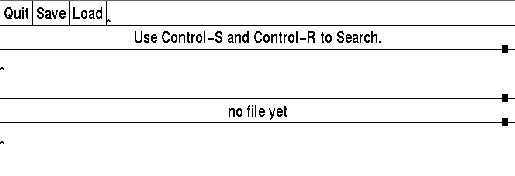Xedit is a text editor for X Windows.
To start xedit, enter the command
xedit,
optionally with the filename of the file you want to edit.
This page presents only the rudiments of xedit. For more detail,
you should read the man page.
The startup screen, if no file is supplied, looks like this:

Loading and Saving Files
The text line along the top of the window, to the right of
Load is for entering a filename. You must move the
cursor into the text area in order to make it active. Enter
the filename you wish to edit, then click on Load.
If you have entered the name correctly, your file should appear.
If you use a relative pathname
for the file, be sure that it is relative to xedit's working
directory.
The Quit and Save are largely self-explanatory.
If there is no filename, you should type one in the top line
before pressing Save. To quit even though you have not
saved the file, press Quit twice.
Search and Replace
Searching and replacing text is done via Control-S and
Control-R. Hold down the Ctrl key on the keyboard,
and press S or R. The only difference is that
S searches forward by default, while R searches
backward by default.
Typing text
The middle text pane is for any error and information messages that
xedit may produce. The bottom pane is for you to type in. Be sure
to keep the mouse pointer in the frame as you type.
To type in a new location, you must move the
text insertion point. Click
the left mouse button where you want the text to go.
Cut and Paste in xedit
With xedit, you have to cut and paste
with the mouse. To delete a
selection, press Ctrl-W.
 Keith Orpen,
who is still writing this, would like to
hear your comments and suggestions.
Keith Orpen,
who is still writing this, would like to
hear your comments and suggestions.


 Keith Orpen,
who is still writing this, would like to
hear your comments and suggestions.
Keith Orpen,
who is still writing this, would like to
hear your comments and suggestions.